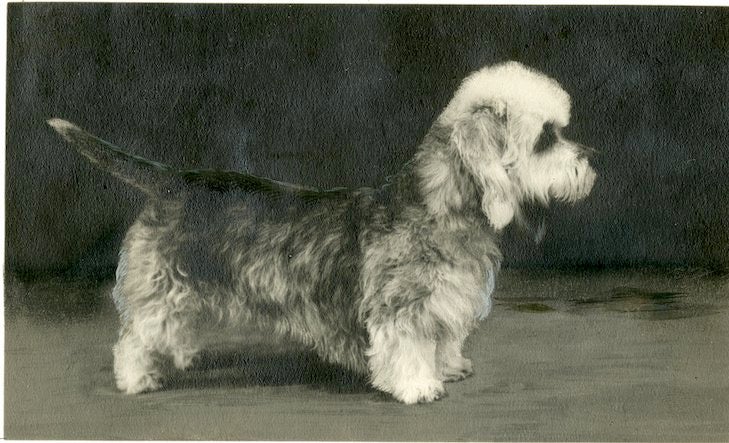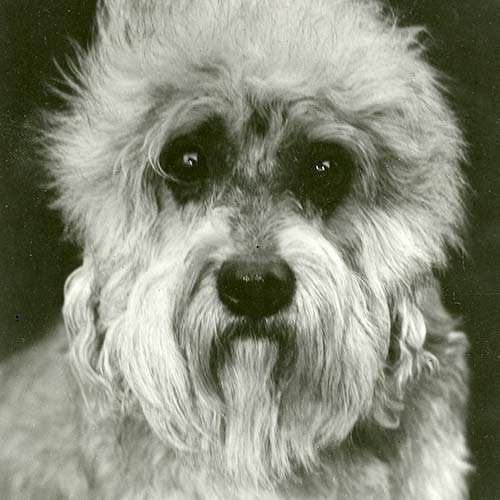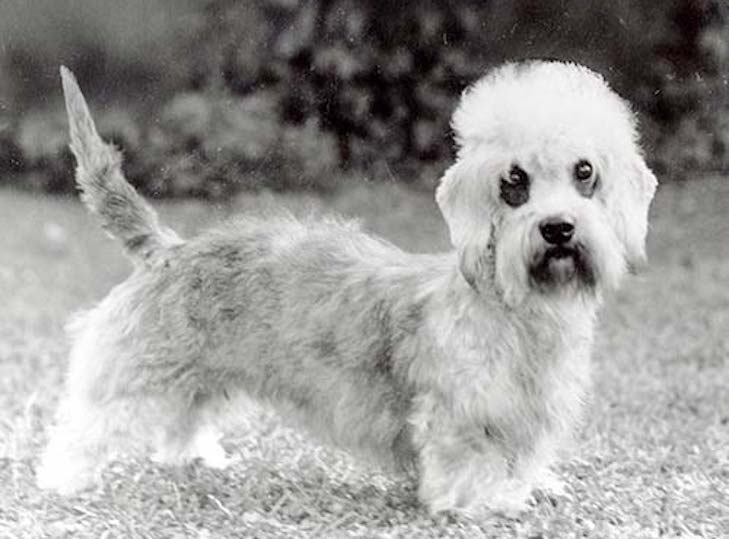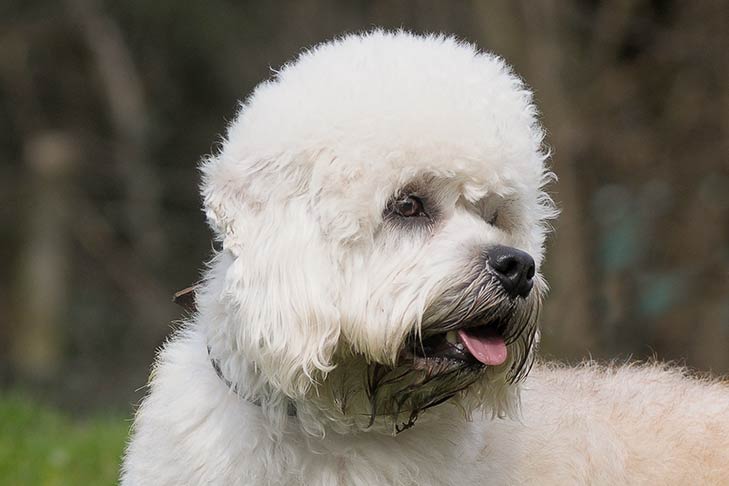
English novelists of centuries past gave us timeless characters who hopscotched from the printed page into our cultural consciousness, from Daniel DeFoe’s “Robinson Crusoe” to Mary Shelley’s “Frankenstein.”
And in the dog world, there is one exceedingly rare terrier that owes its name – and arguably its continued existence – to a peripheral character in a 1815 novel that sold out on its first day of publication.
The book, which you’ve probably never read, is “Guy Mannering.” And the eponymous breed – which, unless you’re a dog maven, you’re likely equally unaware of – is the Dandie Dinmont Terrier.
Guy Mannering
Author Sir Walter Scott set his novel in Northumbria, which straddles the border of northern England and southern Scotland. There, since at least the early 1700s, farmers and tinkers bred a long-bodied terrier with a distinctive topknot, crisp double coat and – not least of all – the fierce determination to vanquish any fox, badger or otter unfortunate enough to cross its path.
Scott knew the rural Scottish Borders well: As a child recovering from polio he had been sent to his grandparents’ farm there to regain his mobility, returning later to be the sheriff of Selkirkshire. Scott had heard of a farmer named James Davidson who kept “pepper-and-mustard terriers” – and who had an “odd humour” of giving only two names to the twenty or so dogs he kept.
In “Guy Mannering,” Davidson morphed into Dandie Dinmont, a rough-hewn but kind-hearted tenant at a fictitious farm called Charlieshope. His pack of six dogs included Auld Pepper, Auld Mustard, Young Pepper, Young Mustard, Little Pepper, and Little Mustard.

From Farm Life to Fame
The publication of the book upended life at Davidson’s Hindlee farm on the edge of the Teviotdale mountains, making his redundantly named dogs famous overnight. Letters arrived from grand lords and ladies, inquiring about buying braces of the low-stationed dogs, whose silhouette one writer of the period described as at first glance “not unlike a low four-footed stool.” Marketers, too, latched on to this new notoriety, applying the breed’s name to locomotives, tobacco, and whiskey blends.
Flattered at the mention, Davidson good-naturedly began answering to the name Dandie Dinmont, though he never read the book. And on the occasions when it was read to him, he promptly fell asleep.
(The rigors of farm life notwithstanding, it was an understandable response: Scott’s tale of a youngster kidnapped by smugglers after he witnesses a murder, and his subsequent adventures and struggle to reclaim his inheritance, has more than its fair share of plot twists and turns.)
Even the great author himself could not escape the breed’s magnetic pull: Scott was given two Dandies, Ginger and Spice, by Davidson. Despite divided loyalties – Scott, who owned Scottish Deerhounds, is responsible for describing that ethereal Sighthound as “the most perfect creature of heaven” – he bred The Mertoun Dandie, who through his daughter Vixen appears in almost every Dandie pedigree the world over.

Where Did Dandie Dinmonts Come From?
As the Dandie Dinmont Terrier became more visible, interest naturally developed about its origins. In the absence of written records, two theories were popular: First, that the Dandie resulted from a cross between the now-extinct Scotch terrier and the Otterhound, which contributed the head structure, low-set ear, and scimitar-like tail carriage, along with some Bulldog blood to give tenacity. Others ascribed to the idea that a long-ago foreign dog was incorporated to produce the unusual silky topknot, perhaps a Dachshund-like terrier accompanying gypsies from the continent crossed with local terriers that resembled overdone Yorkshire Terriers.
What’s certain is that no one can be certain of exactly where the Dandie Dinmont came from. But Davidson was not the only one to breed them. The Allan family of Holystone in Northumberland was associated with these terriers going as far back as the early 1700s. The family patriarch, Willie “Piper” Allan, an avid otter hunter, was hired by Lord Ravenworth to remove them from one of his ponds. After seeing how well the “Piper Terriers” worked, the nobleman tried to purchase one – an offer that Allan steadfastly refused.

Edge of Extinction
While “Guy Mannering” prompted an outsized celebration of the tousled terrier from the Border country, by the late 1800s the Dandie Dimont found itself on the edge of extinction.
One breeder who kept the flickering flame alive was Eaglesfield Bradshaw-Smith, who started breeding in 1841 and continued until his death in 1882. He amassed such a range of dogs that he rarely had to go outside his kennel for new blood, but when he did, he scoured the countryside for quality dogs, making copious notes about them on the spot. All of Bradshaw-Smith’s dogs were tested on game, sometimes severely: Required to work two badgers at a time, the dog would have to survive the attack of one while holding on to the other.
Bradshaw-Smith eventually came to own Old Ginger, who is in the pedigrees of all today’s Dandie Dinmonts. That dog’s father was Old Pepper, who had been caught in a poacher’s trap and so had no pedigree to speak of; his mother was the aforementioned Vixen, sired by Scott’s Mertoun Dandie dog.

Today’s Dandie Dinmonts
Today, the Dandie Dinmont Terrier continues its precarious balancing act. In 2016, because of a shrinking breed population – only 90 were registered that year – the Kennel Club in the United Kingdom recognized the Dandie Dinmont Terrier as a Vulnerable Native Breed; that same year the United States produced only 75 puppies. Things have improved a bit since then – in 2019, the Dandie was ranked 174th out of the 193 breeds recognized by the American Kennel Club in popularity, sandwiched between the Polish Lowland Sheepdog and the American English Coonhound.
But what Dandie Dinmont Terrier fanciers might lack in numbers they more than make up for in passion and a reverence for their breed’s history. In 2017, to celebrate Old Ginger’s 175th birthday, Dandie lovers erected a life-size bronze statue of him at The Haining, the Georgian mansion in Selkirk where he was born, and where his kennel runs still stand. And this June, plans were in place to commemorate the 200-year anniversary of James Davidson’s death at Oxnam Kirk in the Scottish Borders where he is buried, but were canceled due to the coronavirus pandemic.
A minor setback, but one that Dandie fanciers will doubtless overcome. This is, after all, a breed whose owners and breeders are determined to ensure that it won’t end up only to be found in the fusty pages of a long-ago novel.

